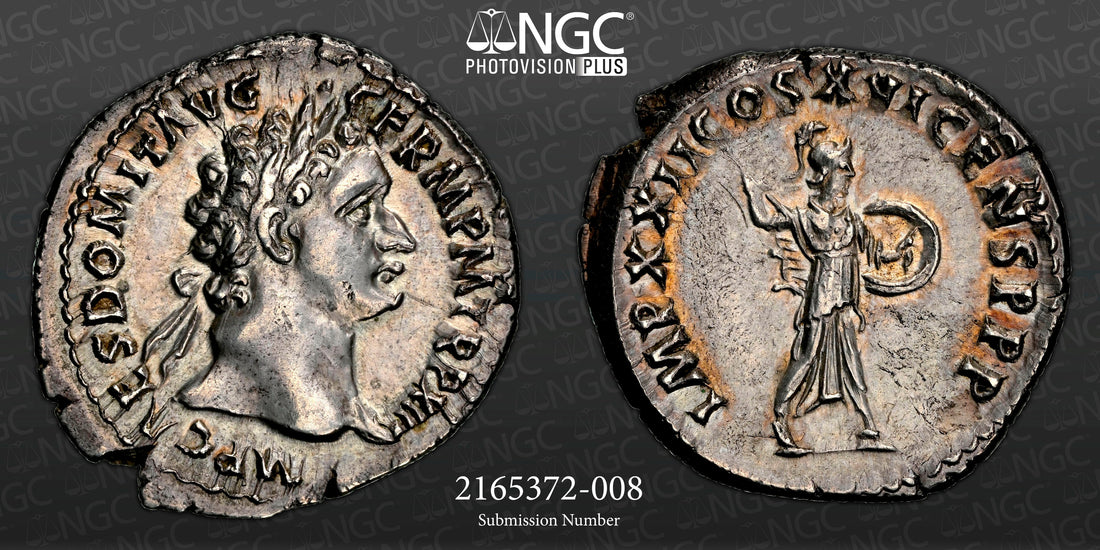
Domitian Denarius (81-96 AD) - A Symbol of Strength, Military Power and Imperial Ideals
Share
Domitian's reign was marked by his efforts to strengthen the power of the emperor and centralize authority. While his early years were relatively peaceful, his later rule became increasingly autocratic, and he used both military victories and religious titles to reinforce his position. Domitian was particularly focused on military campaigns in Germany, which were often depicted in his coinage to highlight his role as a military leader. He sought to extend Roman dominance in the northern provinces and secure the empire’s borders. Additionally, Domitian was known for his building projects and his attempts to restore discipline to the Roman army. His image was also used to promote a sense of security and continuity in the empire. The inclusion of Minerva, the goddess of both wisdom and war, on the reverse of this coin, further demonstrates Domitian’s ambition to be seen as a ruler who could navigate both the strategic and intellectual demands of governance.
The Obverse: The Laureate Head of Domitian
The obverse of the Domitian denarius features a laureate head of the emperor facing right, with the inscription IMP CAES DOMIT AVG GERM PM TRP XV surrounding the image.
The laureate crown that adorns Domitian’s head is a powerful symbol in Roman iconography. The laurel wreath was a mark of military success, typically awarded to generals and emperors who had achieved victories on the battlefield. For Domitian, this symbol was significant, as it underscored his military accomplishments, including his campaigns in Germany, which were a major part of his reign. The image of the laureate head serves not only to reinforce his image as a victorious leader but also to remind the Roman populace of his continued strength and martial prowess.
The inscription IMP CAES DOMIT AVG GERM PM TRP XV translates to "Imperator Caesar Domitian Augustus Germanicus, Pontifex Maximus, Tribune of the People for the fifteenth time."
- IMP refers to his title of Imperator, marking his military command and victories.
- CAES refers to Caesar, affirming Domitian’s connection to the imperial family and the Flavian dynasty, and DOMIT is short for Domitianus, his name.
- AVG stands for Augustus, a title denoting his position as emperor, and GERM signifies his victories in the Germanic campaigns.
- PM stands for Pontifex Maximus, the chief priest of Roman religion, emphasizing his role in overseeing religious duties.
- TRP XV indicates his fifteenth term as Tribunicia Potestas, or Tribune of the People, a title that granted him significant political power and the ability to protect the rights of the Roman citizens.
Through this inscription, Domitian reinforced his military achievements, religious authority, and political power - highlighting his role as both a conqueror and a protector of Roman values.
The Reverse: Minerva as a Symbol of Wisdom and Military Might
On the reverse side of the denarius, we see an image of Minerva, the Roman goddess of wisdom and war, walking to the right. She holds a spear in her right hand, with a shield on her left arm. The inscription IMP XXII COS XVII CENS P P accompanies this powerful image.
Minerva was one of Rome's most revered deities, associated not only with wisdom but also with strategic warfare. By depicting Minerva in the act of walking, Domitian aligned himself with the goddess, symbolizing both the intellectual and military strength of his reign. Minerva’s shield and spear suggest protection and martial power, while her serene yet purposeful walk communicates the emperor's steady leadership in times of war and peace.
The inscription IMP XXII COS XVII CENS P P refers to Domitian's various titles and honours:
- IMP XXII denotes his twenty-second acclamation as Imperator, a testament to his numerous military successes.
- COS XVII marks his seventeenth term as consul, a significant political office in the Roman Republic that continued to hold importance during the empire.
- CENS refers to his role as Censor, a title he held to oversee moral and social order in Rome.
- P P stands for Pater Patriae, or "Father of the Fatherland," a title bestowed upon emperors to indicate their protective role over the Roman state and its people.
The use of Minerva on the reverse of the coin underscores Domitian's desire to be seen not only as a military conqueror but also as a wise and responsible ruler, who sought to balance the needs of the empire with his desire for military expansion and power.
Imperial Messaging Through Coins
Coins in ancient Rome were far more than just currency; they were vital tools of propaganda. Emperors used coinage to convey messages about their leadership, military achievements, and their connection to the Roman gods and ideals. The Domitian denarius is a prime example of this practice. Through the coin's imagery and inscriptions, Domitian made it clear that his reign was defined by military success, divine favour, and a strong commitment to Roman tradition.
By featuring the image of Minerva, Domitian sought to convey that he was not just a military ruler, but also a wise and prudent leader, one who could balance the demands of war with the strategic insight of a ruler who understood the importance of peace and order. The coin's carefully constructed inscriptions served as a reminder of his extensive political power and his lasting contributions to Rome.
Domitian’s Legacy in Coinage
The Domitian denarius minted between 81-96 AD encapsulates the themes that defined the emperor's rule: military success, strong imperial authority, and a connection to the gods. The coin’s imagery of Minerva, paired with the detailed inscriptions, tells the story of an emperor who sought to project strength, intelligence, and wisdom throughout his reign. Though Domitian’s rule was not without its controversies, his use of coinage to promote his image as a powerful, wise, and legitimate ruler remains a key part of his legacy.
For collectors and historians alike, this denarius serves as a fascinating reflection of the political and military ideals of one of Rome’s most complex emperors. It offers a glimpse into the world of Roman imperial propaganda, showing how emperors like Domitian used coinage to solidify their power, shape their public image, and ensure their legacy.
